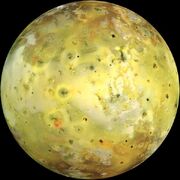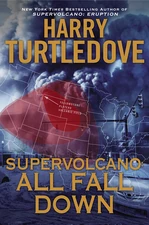
Jovian moon Io.
Io is the innermost of the four Galilean moons of Jupiter and, with a diameter of 3642 km, the fourth-largest moon in the Solar System.
Io orbits Jupiter at a distance of 421,700 km (262,000 mi) from the planet's center and 350,000 km (217,000 mi) from its cloud tops. It takes 42.5 hours to revolve once around Jupiter and rotates synchronously with its orbital period. This keeps one face pointed toward Jupiter at all times. Jupiter spreads twenty degrees across Io's sky or forty times the width of the Moon as seen from the Earth.
With over 400 active volcanoes, Io is the most geologically active object in the Solar System. This extreme geologic activity is the result of tidal heating from friction generated within Io's interior by Jupiter's varying pull. Several volcanoes produce plumes of sulfur and sulfur dioxide that climb as high as 500 km (310 mi). Io's surface is also dotted with more than 100 mountains that have been uplifted by extensive compression at the base of the moon's silicate crust. Unlike most satellites in the outer Solar System (which have a thick coating of ice), Io is primarily composed of silicate rock surrounding a molten iron or iron sulfide core. Most of Io's surface is characterized by extensive plains coated with sulfur and sulfur dioxide frost.
Io in "La Différence"
In the early 21st Century, United Europe had established several research bases on Io. A dispute over mining rights in the asteroid belt with Japan led to war with Japan striking the first blow in a surprise attack on Sengen Base and Loki Station. Japan did not have any bases on Io but landed personnel from the Moon after the attack.
Io in Supervolcano
When Colin Ferguson looked at the photographs Kelly Birnbaum took of Yellowstone National Park from forty thousand feet after the supervolcano had erupted, he said it reminded him of the sausage-and-anchovy pizza moon of Jupiter. Kelly identified the moon as Io to which Colin agreed. The photos showed a red and black volcanic landscape which did resemble the surface of that moon.[1]
References
| ||||||||
| |||||||||||||


